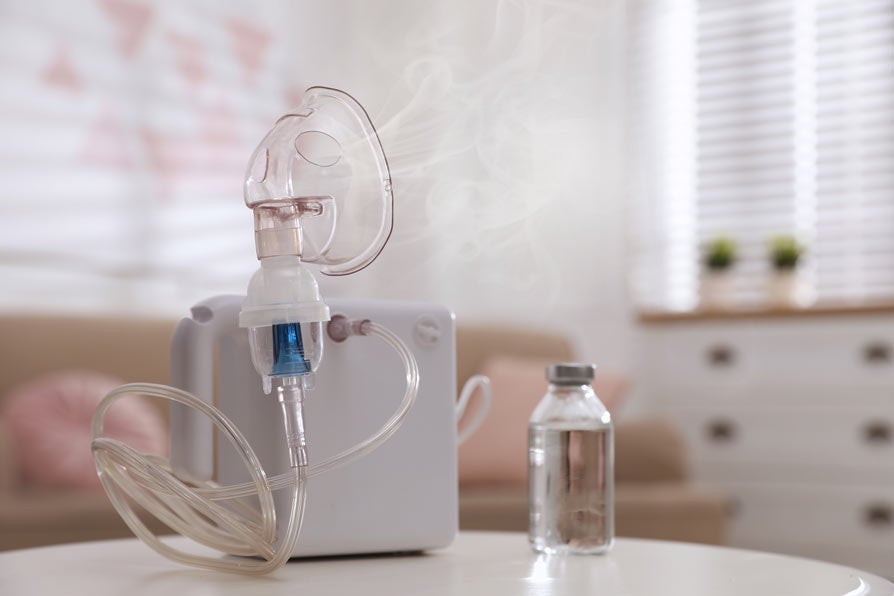A nebulizer is a device that sprays a fine, liquid mist of medicine. It is often used in younger children who can't use inhalers. The device has an air compressor, a cup for medicine, and tubing connected to a mouthpiece or mask. Your child breathes in the medicine through the mouthpiece or mask. Each treatment takes about 15 to 20 minutes to complete.
There are several different types of nebulizers used for asthma medicine. They are:
-
Jet nebulizers.
-
Ultrasonic nebulizers.
-
Mesh nebulizers.
The instructions are slightly different for each. Be sure you know how to use your child's nebulizer.
Giving a treatment
The following steps are advised when giving a treatment to your child. But always talk with your child's health care provider for specific directions. Directions will also vary by specific nebulizer. Make sure you know how to use yours.
-
Wash your hands with soap and clean, running water. Gather supplies needed, including:
-
Medicine to be nebulized and extra nebulizing solution, such as sterile saline, if needed.
-
Nebulizer set. This is the nebulizer cup, mouthpiece or mask, and tubing to connect to the nebulizer machine.
-
-
Find a quiet activity for your child to do while they sit up for the treatment. For instance, they might read a book, draw, or play a quiet game.
-
Place the nebulizer on a flat surface. This might be on a table or the floor.
-
Plug the unit into a wall outlet.
-
Connect the tubing to the nebulizer machine.
-
Put the prescribed amount of medicine into the nebulizer cup and screw the cap on securely. Some medicine may be premixed. Other medicine may need to be measured.
-
Connect the other end of the air tubing to the nebulizer cup.
-
Connect the mouthpiece or face mask to the nebulizer cup.
-
Turn the machine on.
-
Check to make sure that a fine mist of medicine is coming through the face mask or mouthpiece. Most nebulizer cups need to be held upright to work correctly.
Mouthpiece:
-
Place the mouthpiece in your child's mouth with their lips sealed around it.
-
Encourage your child to take slow, deep breaths in and out of their mouth. The mist should disappear with each breath.
Face mask:
-
Place the mask over your child's mouth and nose. The adjustable elastic band may be used to hold the mask in place.
-
Encourage your child to take deep breaths in and out for the entire treatment.
-
-
Have your child keep taking slow, deep breaths until all the medicine in the nebulizer cup is gone. You may need to tap the sides of the nebulizer cup to make sure all medicine is given.
-
Turn the nebulizer off, and remove the mouthpiece or mask.
-
If you check your child's peak flow, make sure you measure it before and after the treatment.
If the medicine is an inhaled corticosteroid, have your child rinse their mouth with water and spit it out. If your child used a mask, also wash their face.
After each treatment
-
Disconnect the nebulizer cup from the tubing.
-
Open the cup, and wash all pieces according to the instructions that came with the nebulizer. Also clean the mouthpiece or mask.
-
Air-dry on a clean towel. Wash your hands with soap and clean, running water.
-
Store the dried nebulizer cup and tubing in a plastic bag.
-
Once a week, rinse the nebulizer cup in a vinegar and water solution after washing, as directed by your child's provider. Follow specific instructions for routinely disinfecting the nebulizer, mouthpiece, and mask.
Notes for parents
-
Stay with your child during the nebulizer treatment.
-
If your child vomits or has a severe coughing spell during the treatment, stop the treatment. Let your child rest for a few minutes, then resume the treatment.
-
Check the filter on the nebulizer machine once a week. When it becomes discolored, replace it with a new filter.
-
Always keep spare nebulizer supplies at home. Before you run out, call your medical supply company.
Featured in


